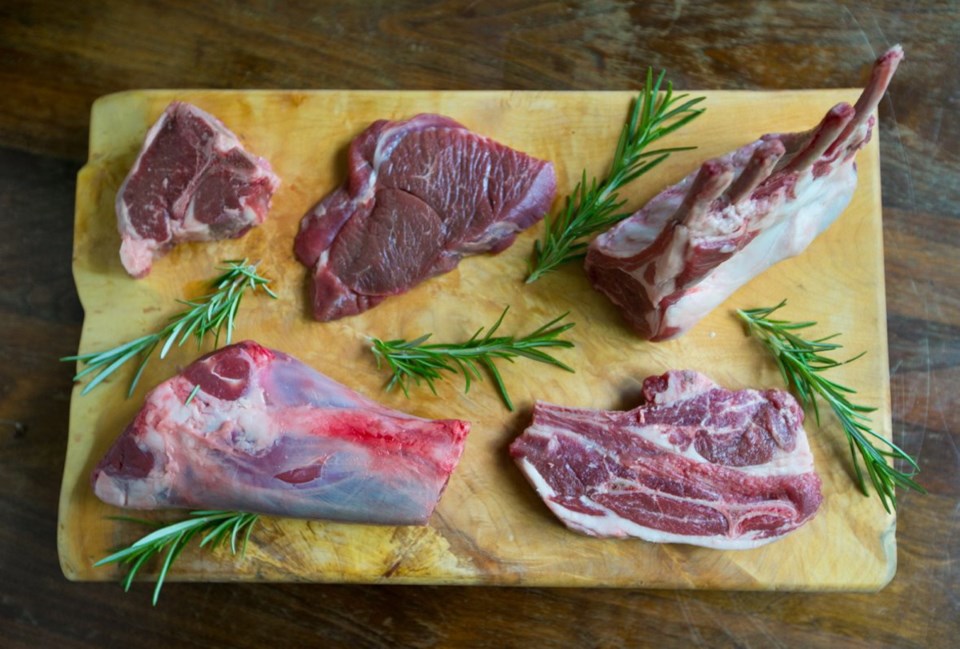 Dear Eric: I feel like I want to eat more lamb, but I don’t know what cuts to buy. Can you help?
Dear Eric: I feel like I want to eat more lamb, but I don’t know what cuts to buy. Can you help?
Jill
Dear Jill: Despite being widely available in Canada, lamb still plays second fiddle to other meats, such as beef, pork and chicken.
That’s because many Canadians don’t have the same culture of regularly eating lamb as in other places. But ,according to a report by the Canadian Lamb Producers, the taste for lamb in Canada is growing every year and that fact is evident in the meat display case of grocery stores and butcher shops.
Although lamb still takes up just a small space when compared to other meats, the types of cuts you can now purchase have widened. And, at butcher shops in particular, you can readily buy local lamb, from places such as Parry Bay Sheep Farm in Metchosin (parrybaysheepfarm.com).
While that is great, someone like Jill and others unfamiliar with how to prepare various lamb cuts will shy away from buying them. To assist, I’ve listed some of those cuts, offered a photograph for most of them and suggested ways to use them.
Leg roasts and steaks: These tender cuts come from the back leg. When sold as a roast, you can buy a nicely trimmed whole leg, or one that's cut and tied into smaller bone-in or boneless roasts. Leg roasts are, of course, great for roasting, but could also be cooked on a rotisserie or directly on the grill of your barbecue. The latter is particularly true if the leg has been boned and butterflied by your butcher, where the meat is opened up and looks more like a large, thick steak. The upper part of the leg, the sirloin, is also sliced into steaks and medallions, which can be cooked like any other tender meat steak, by methods such as grilling and pan searing.
Lamb shoulder roast and chops: These are tougher cuts because they come from the front shoulder of the animal, where there’s more connective tissue. If you marinate them, you could still cook them like you do more tender cuts. However, they are better suited to oven braising, where you cook them in a flavour liquid until succulently tender, like you would a beef pot roast or braising steak.
Rack of lamb: This tender, premium cut taken from the rib section could be called the “prime rib” of lamb. A whole rack will have seven to eight rib bones. Cut that rack in half and you get two nice portions. Most lamb racks are sold “frenched.” That means much of the fat is removed and the top part of the rib bones are cleaned and exposed, making for a nicer presentation. Rack of lamb is easy to cook. I often simply brush the meat with Dijon mustard and season it with chopped rosemary or mint, pepper and sea salt. Roast it at 425 F until medium rare, which will takes about 25 to 30 minutes, depending on the thickness.
Lamb loin and rib chops: Cut a lamb rack into individual chops and you get rib chops. If you cut chops from the loin, located beside the rib section, you get tender, mini-T-bone-steak-like lamb loin chops. Both of these tender types of lamb chops can be seasoned and grilled, pan-seared or broiled to your desired doneness. Allow about three to four minutes per side for medium rare to medium. I’ve also cooked these chops in a casserole and provided the recipe here.
Lamb shanks: This tough cut is taken from the lower, shin portion of the leg. But the shank will become deliciously tender when slowly oven braised for two to three hours in a flavoured liquid, such as red wine, saucy tomatoes, garlic and herbs.
Ground lamb: Grinding some of the cuts above is how ground lamb is made. It can be used in ways you would use other the types of ground meat, such as burgers, meatballs and casseroles. As with ground beef, ground lamb needs to be cooked to 160 F or above.
Lemony Lamb Chops with Artichokes, Olives and Mint
This recipe is from my first book, Everyone Can Cook. Serve this Mediterranean-style lamb dish with boiled new potatoes or orzo pasta.
Preparation time: 20 minutes
Cooking time: 22 minutes
Makes: Four to six servings
12 lamb loin chops
• salt and freshly ground black pepper to taste
3 Tbsp olive oil
1 (14 oz./398 mL) tin artichokes hearts, drained well and quartered
1/3 cup whole black olives
1/3 cup whole green olives
• grated zest and juice of 1 lemon
1 cup white wine or chicken stock
2 Tbsp chopped fresh mint
• lemon slices for garnish
Preheat oven to 450°F.
Season the lamb with salt and pepper. Heat the oil in a large skillet set over medium-high.
Quickly sear the lamb, in batches, on both sides, and then transfer to a casserole large enough to hold them in a single layer.
Arrange artichokes and olives around the lamb. Top with lemon zest and juice.
Pour in wine or stock. Cover and bake 20 minutes, or until lamb reaches the desired degree of doneness.
Uncover and sprinkle the lamb with chopped mint.
Garnish with lemon slices and serve.
Eric Akis is the author of The Great Rotisserie Chicken Cookbook (Appetite by Random House). His columns appear in the Life section Wednesday and Sunday.



